英语学习—浅谈双词短语
兼语短语名词解释
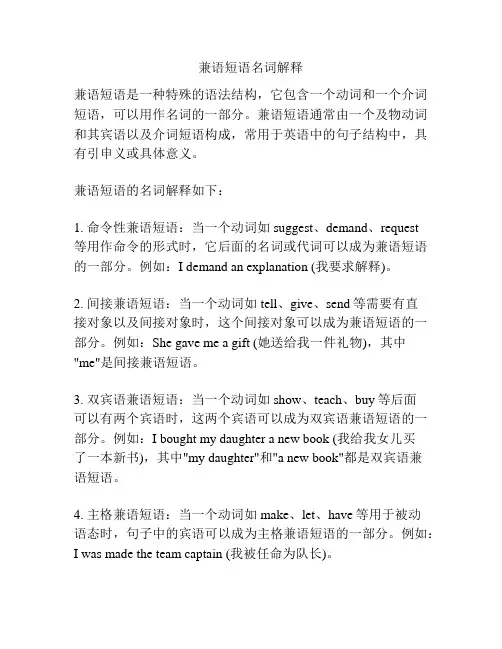
兼语短语名词解释兼语短语是一种特殊的语法结构,它包含一个动词和一个介词短语,可以用作名词的一部分。
兼语短语通常由一个及物动词和其宾语以及介词短语构成,常用于英语中的句子结构中,具有引申义或具体意义。
兼语短语的名词解释如下:1. 命令性兼语短语:当一个动词如suggest、demand、request等用作命令的形式时,它后面的名词或代词可以成为兼语短语的一部分。
例如:I demand an explanation (我要求解释)。
2. 间接兼语短语:当一个动词如tell、give、send等需要有直接对象以及间接对象时,这个间接对象可以成为兼语短语的一部分。
例如:She gave me a gift (她送给我一件礼物),其中"me"是间接兼语短语。
3. 双宾语兼语短语:当一个动词如show、teach、buy等后面可以有两个宾语时,这两个宾语可以成为双宾语兼语短语的一部分。
例如:I bought my daughter a new book (我给我女儿买了一本新书),其中"my daughter"和"a new book"都是双宾语兼语短语。
4. 主格兼语短语:当一个动词如make、let、have等用于被动语态时,句子中的宾语可以成为主格兼语短语的一部分。
例如:I was made the team captain (我被任命为队长)。
5. 介词兼语短语:当一个动词如depend、rely、complain等需要跟介词短语时,这个介词短语可以成为介词兼语短语的一部分。
例如:He relied on his friends for support (他依靠他的朋友们得到支持),其中"on his friends"是介词兼语短语。
兼语短语在英语中十分常见,可以丰富句子的表达方式,并使句子更加准确和具体。
通过理解和使用兼语短语,可以使句子更加流利和自然,并提高语言表达的能力。
双词短语
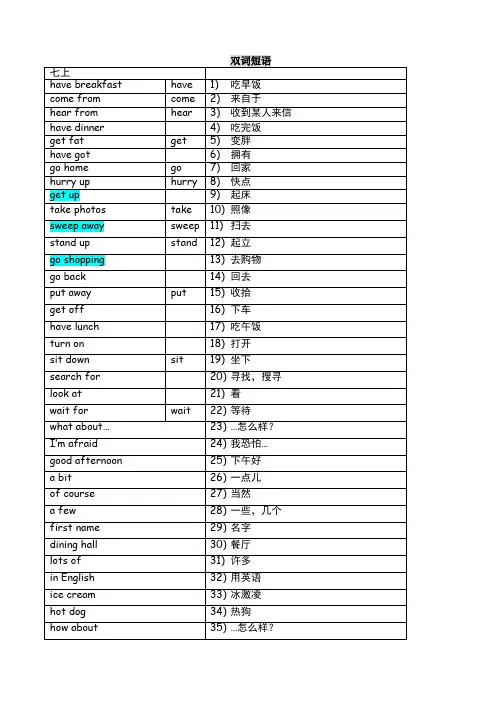
good morning
41)早上好
last name
42)姓氏
how many
43)多少
a little
44)一点儿
at weekends
45)在周末
at work
46)在工作
七下
go out
go
47)出去
pick up
48)接,捡起
enjoy oneself
enjoy
49)过得快乐
cometrue
187)最后一句话,最终决定
atleast
188)至少;起码
millions of
189)大量的;无数的
morethan
190)超过
no good
191)不合适的;不方便的
no longer
192)不再
no way
193)绝不;不可能
no wonder
194)难怪;不足为奇
once again
195)再一次
29)名字
dining hall
30)餐厅
lots of
31)许多
in English
32)用英语
ice cream
33)冰激凌
hot dog
34)热狗
how about
35)…怎么样?
such as
36)比如
on sale
37)出售
over there
38)在那边
next to
39)挨着
too much
179)即使;尽管
according to
180)根据;按照;根据…所说
on business
181)出差
英文词组的定义
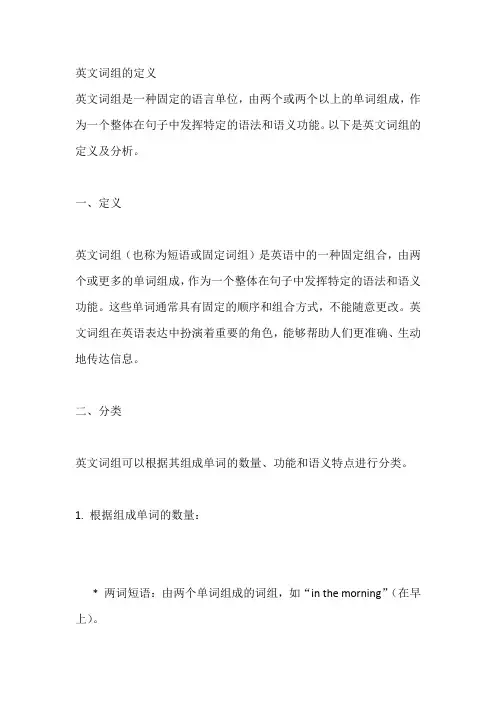
英文词组的定义英文词组是一种固定的语言单位,由两个或两个以上的单词组成,作为一个整体在句子中发挥特定的语法和语义功能。
以下是英文词组的定义及分析。
一、定义英文词组(也称为短语或固定词组)是英语中的一种固定组合,由两个或更多的单词组成,作为一个整体在句子中发挥特定的语法和语义功能。
这些单词通常具有固定的顺序和组合方式,不能随意更改。
英文词组在英语表达中扮演着重要的角色,能够帮助人们更准确、生动地传达信息。
二、分类英文词组可以根据其组成单词的数量、功能和语义特点进行分类。
1. 根据组成单词的数量:* 两词短语:由两个单词组成的词组,如“in the morning”(在早上)。
* 三词短语:由三个单词组成的词组,如“in the morning light”(在晨光中)。
* 多词短语:由四个或更多单词组成的词组,如“in the morning light of day”(在清晨的曙光中)。
2. 根据功能:* 名词短语:以名词为中心,如“in the morning”(在早上)。
* 动词短语:以动词为中心,如“to look at”(看待)。
* 形容词短语:以形容词为中心,如“very good”(非常好)。
3. 根据语义特点:* 名词性短语:具有名词的语义特征,如“in the morning”(在早上)。
* 动词性短语:具有动词的语义特征,如“to look at”(看待)。
* 形容词性短语:具有形容词的语义特征,如“very good”(非常好)。
三、语法和语义功能英文词组在句子中可以扮演不同的语法和语义角色。
它们可以作为句子中的主语、谓语、宾语、定语、状语等成分,也可以表达各种语义关系,如时间、地点、方式、原因、条件等。
例如:1. As a noun phrase, “in the morning”can serve as the subject of a sentence.(作为名词短语,“在早上”可以作为句子的主语。
总结五种短语类型的知识点
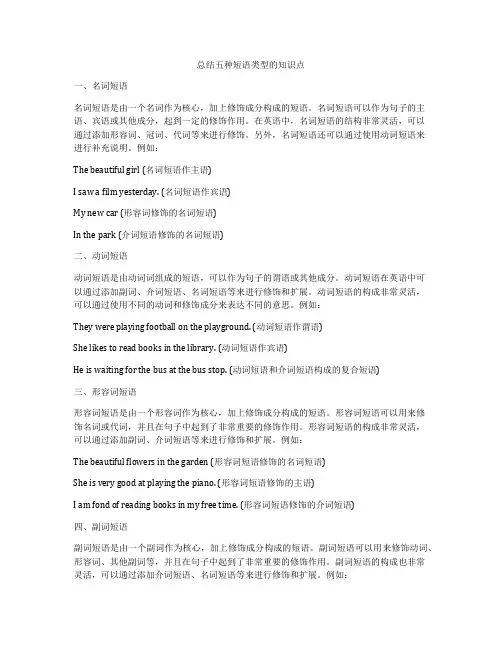
总结五种短语类型的知识点一、名词短语名词短语是由一个名词作为核心,加上修饰成分构成的短语。
名词短语可以作为句子的主语、宾语或其他成分,起到一定的修饰作用。
在英语中,名词短语的结构非常灵活,可以通过添加形容词、冠词、代词等来进行修饰。
另外,名词短语还可以通过使用动词短语来进行补充说明。
例如:The beautiful girl (名词短语作主语)I saw a film yesterday. (名词短语作宾语)My new car (形容词修饰的名词短语)In the park (介词短语修饰的名词短语)二、动词短语动词短语是由动词词组成的短语,可以作为句子的谓语或其他成分。
动词短语在英语中可以通过添加副词、介词短语、名词短语等来进行修饰和扩展。
动词短语的构成非常灵活,可以通过使用不同的动词和修饰成分来表达不同的意思。
例如:They were playing football on the playground. (动词短语作谓语)She likes to read books in the library. (动词短语作宾语)He is waiting for the bus at the bus stop. (动词短语和介词短语构成的复合短语)三、形容词短语形容词短语是由一个形容词作为核心,加上修饰成分构成的短语。
形容词短语可以用来修饰名词或代词,并且在句子中起到了非常重要的修饰作用。
形容词短语的构成非常灵活,可以通过添加副词、介词短语等来进行修饰和扩展。
例如:The beautiful flowers in the garden (形容词短语修饰的名词短语)She is very good at playing the piano. (形容词短语修饰的主语)I am fond of reading books in my free time. (形容词短语修饰的介词短语)四、副词短语副词短语是由一个副词作为核心,加上修饰成分构成的短语。
英语学习的短语
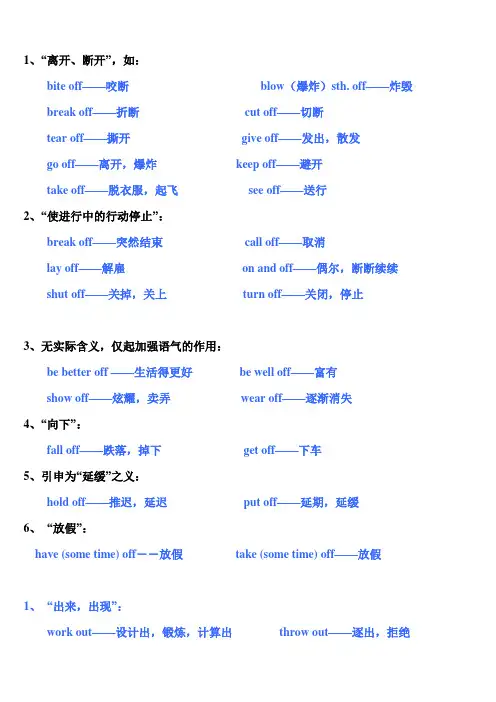
1、“离开、断开”,如:bite off——咬断 blow(爆炸)sth. off——炸毁break off——折断cut off——切断tear off——撕开give off——发出,散发go off——离开,爆炸 keep off——避开take off——脱衣服,起飞see off——送行2、“使进行中的行动停止”:break off——突然结束call off——取消lay off——解雇on and off——偶尔,断断续续shut off——关掉,关上turn off——关闭,停止3、无实际含义,仅起加强语气的作用:be better off ——生活得更好be well off——富有show off——炫耀,卖弄wear off——逐渐消失4、“向下”:fall off——跌落,掉下get off——下车5、引申为“延缓”之义:hold off——推迟,延迟put off——延期,延缓6、“放假”:have (some time) off--放假take (some time) off——放假1、“出来,出现”:work out——设计出,锻炼,计算出throw out——逐出,拒绝take out——拿出,取出stick (伸出)out——突出bring out出现,出版come out——出现,显露day in day out——日日夜夜set out——起身,开始stand out——突出,杰出figure out——想出,算出find out——查明,查出hand out——拿出,取出have it out with ——讲明白,摊牌make out——成功,表现,了解pick out ——选择,挑选point out——指出2、“外出,向外” :eat out——外出吃饭give out——分发go out——外出hand out——分发keep out——使不能进入look out——小心,注意look out on/up on——面对stay out——外出watch out for——监视,留意be out of the question——绝无可能3、“熄灭,一点不剩” :blow out ——吹灭,吹熄burn out——熄灭give out——用尽put out——关掉,扑灭,熄灭go out——熄灭out of ——用尽run out of——用光,耗尽sell out——售完4、out的常见含义还包括“退出,离开”:back out ——退出,食言drop out——退出,离去get out ——离开go out——离开out of ——离开move out of——迁出,离开5、out也有“移除,脱离”的含义:clean out ——扫除,清除cross out ——删除,勾销cut out——割离,排除grow out of ——消除,戒除,不合身out of (时间)——过时out of order——故障,损坏6、out有时候无实际含义,起加强语气的作用:carry out ——开展,执行die out ——消失,灭绝cry out ——晾干try out ——尝试,试用break out ——爆炸,突然发生turn out ——变成,变得7、out还有“完全,彻底”的含义:buy out——买断,买进fill out ——填妥,填写hold out ——撑到最后knock out ——击倒,击昏tired out ——筋疲力尽wear out ——穿破,穿坏。
英语短语结构分类归纳
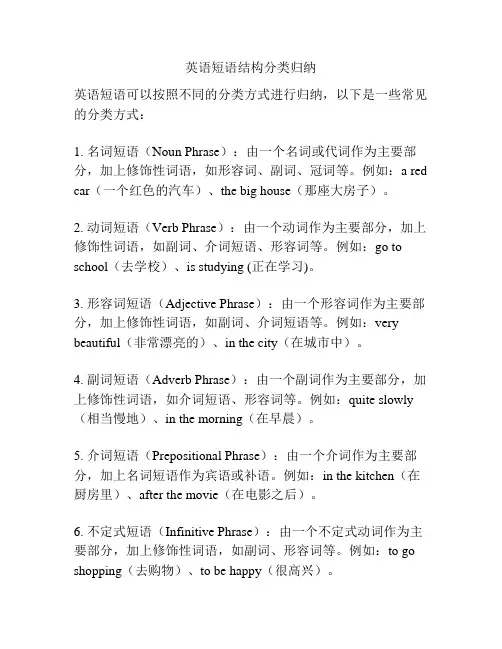
英语短语结构分类归纳英语短语可以按照不同的分类方式进行归纳,以下是一些常见的分类方式:1. 名词短语(Noun Phrase):由一个名词或代词作为主要部分,加上修饰性词语,如形容词、副词、冠词等。
例如:a red car(一个红色的汽车)、the big house(那座大房子)。
2. 动词短语(Verb Phrase):由一个动词作为主要部分,加上修饰性词语,如副词、介词短语、形容词等。
例如:go to school(去学校)、is studying (正在学习)。
3. 形容词短语(Adjective Phrase):由一个形容词作为主要部分,加上修饰性词语,如副词、介词短语等。
例如:very beautiful(非常漂亮的)、in the city(在城市中)。
4. 副词短语(Adverb Phrase):由一个副词作为主要部分,加上修饰性词语,如介词短语、形容词等。
例如:quite slowly (相当慢地)、in the morning(在早晨)。
5. 介词短语(Prepositional Phrase):由一个介词作为主要部分,加上名词短语作为宾语或补语。
例如:in the kitchen(在厨房里)、after the movie(在电影之后)。
6. 不定式短语(Infinitive Phrase):由一个不定式动词作为主要部分,加上修饰性词语,如副词、形容词等。
例如:to go shopping(去购物)、to be happy(很高兴)。
7. 同位语短语(Appositive Phrase):用来对一个名词或代词进行解释或补充说明的短语。
例如:My sister, a doctor(我的妹妹,一个医生)。
请注意,以上分类方式并不是全部,还有其他更具体的分类方式,如动词短语可以分为时态短语、进行时短语等。
不同的语法书籍和教材可能会使用不同的分类方式,所以具体分类还可以根据实际需要进行调整。
浅析英语双重谓语动词结构
举例说明单词句与双词句的主要特点
举例说明单词句与双词句的主要特点
单词句是指由一个单词构成的句子,而双词句是指由两个词组成的句子。
它们的主要特点如下:
单词句:
1.简洁明了:单词句只包含一个词,因此句子信息量相对较少,表达
的意思相对单一
例如:
-"Go!"(走!)
- "Stop!"(停!)
2.语境依赖:单词句通常需要依赖上下文才能明确表达出完整的意思。
例如:
- "Run!"如果是在操场上喊的,可能是鼓励对方跑步;如果是在看到
危险的时候喊的,可能是要求对方逃跑。
双词句:
1.更具表达能力:双词句由两个词组成,信息量相对较大,可以表达
更复杂的意义。
例如:
- "Good morning!"(早上好!)
- "Please wait!"(请等待!)
2.独立完整:双词句本身就是一个完整的语言单位,不需要依赖其他上下文来明确表达意思。
例如:
- "Thank you!"(谢谢!)是一个独立的表达感谢的句子,没有其他语境,也可以明确传达意思。
总体而言,单词句的特点是简洁、语境依赖,一般只能表达基本的命令或感叹;而双词句具有更多的表达能力,独立完整,可以表达更加复杂的意义。
多重短语英语
多重短语英语Multiword Expressions in EnglishMultiword expressions (MWEs) are a fundamental aspect of natural language that present unique challenges and opportunities in the field of linguistics and language processing. These expressions, which consist of two or more words that function as a single semantic or syntactic unit, are ubiquitous in everyday speech and writing, and their understanding is crucial for effective communication and language comprehension.One of the defining features of MWEs is their idiomatic nature, where the meaning of the entire expression cannot be deduced from the literal meanings of its individual components. For example, the phrase "kick the bucket" does not refer to the physical act of kicking a bucket, but rather the idiomatic meaning of "to die." This idiomatic quality is what sets MWEs apart from literal, compositional language, and it is this very characteristic that makes them both fascinating and challenging to study and process.Another key feature of MWEs is their syntactic flexibility, or lack thereof. While some MWEs, such as "by and large," are fixed expressions that cannot be altered without losing their meaning, others, like "take a look," can undergo certain grammatical transformations, such as "took a look" or "will take a look." This flexibility, or lack thereof, adds an additional layer of complexity to the study and understanding of MWEs.The prevalence of MWEs in natural language is staggering. Estimates suggest that MWEs account for a significant portion of the lexicon, with some studies suggesting that they may comprise up to 50% of all language use. This ubiquity is a testament to the importance of these expressions in human communication, as they allow speakers to convey complex ideas and nuanced meanings in a concise and efficient manner.The study of MWEs has important implications for a wide range of fields, including natural language processing (NLP), language learning, and cognitive linguistics. In the realm of NLP, the accurate identification and interpretation of MWEs is crucial for tasks such as machine translation, information retrieval, and text summarization. Failing to recognize and properly handle MWEs can lead to significant errors and misunderstandings in these applications.Similarly, in language learning, the mastery of MWEs is a keycomponent of achieving fluency and natural-sounding speech. Learners often struggle to understand and produce idiomatic expressions, and the ability to recognize and use MWEs is a hallmark of advanced language proficiency.From a cognitive linguistic perspective, the study of MWEs provides valuable insights into the way the human mind processes and organizes language. The fact that certain word combinations are stored and accessed as single units, rather than as individual words, suggests that language is not simply a matter of stringing together discrete lexical items, but rather a complex and dynamic system of interconnected conceptual representations.Despite the importance of MWEs, their study and treatment in language research and applications has not always been straightforward. One of the primary challenges is the sheer diversity and complexity of these expressions, which can range from simple idioms to more elaborate constructions, such as collocations, phrasal verbs, and compound nouns. This diversity makes it difficult to develop a unified theory or approach to the study of MWEs.Additionally, the identification and classification of MWEs can be a complex and subjective process, as the boundaries between literal and idiomatic language are not always clear-cut. Determining whether a particular expression should be considered an MWE or afree combination of words can be a matter of debate, and this ambiguity can complicate the development of robust and reliable MWE recognition systems.Another challenge in the study of MWEs is the fact that they are often highly context-dependent, with their meaning and usage varying based on the specific linguistic and cultural context in which they occur. This context-sensitivity can make it difficult to develop generalized models or rules for the interpretation and processing of MWEs.Despite these challenges, the study of MWEs remains an active and important area of research in linguistics and language processing. Researchers and practitioners are continually working to develop more sophisticated approaches to the identification, classification, and interpretation of these expressions, with the ultimate goal of improving our understanding of natural language and enhancing the performance of language-based technologies.One promising area of research in this field is the use of machine learning and data-driven approaches to the study of MWEs. By leveraging large corpora of natural language data, researchers can develop statistical models and algorithms that can automatically identify and classify MWEs, based on their linguistic and contextual features. These data-driven approaches have the potential toovercome some of the limitations of more traditional, rule-based methods, and to provide new insights into the patterns and behaviors of MWEs in natural language.Another area of research that holds promise for the study of MWEs is the integration of linguistic and cognitive theories into language processing systems. By incorporating insights from fields such as cognitive linguistics, psycholinguistics, and neurolinguistics, researchers can develop more sophisticated models of language comprehension and production that can better account for the role of MWEs in human language use.Ultimately, the study of multiword expressions in English, and in natural language more broadly, is a complex and multifaceted endeavor that will continue to challenge and fascinate linguists, language researchers, and language technology developers for years to come. As we deepen our understanding of these ubiquitous and idiomatic expressions, we will not only enhance our ability to communicate and interact effectively, but also gain valuable insights into the fundamental nature of human language and cognition.。
初中英语学习需要掌握哪些单词和短语?
初中英语学习需要掌握哪些单词和短语?初中英语学习,那些必须会的单词和短语!别看现在初中的孩子英语水平好像都挺高,各种牛逼的app,什么单词都掌握起来还挺快,但实际情况…嘿嘿,我可是见过不少真实案例的。
就说我侄子吧,小家伙现在初二,暑假前还跟我吹牛逼,说他英语成绩贼好,词汇量都超过高中生了,还准备参加什么英语考试,我当时就乐了,心想这孩子怎么这么自信?结果第二天,我就见识到他这“过人”的英语水平了。
他和朋友在玩“你画我猜”,朋友画了一个人正在喝茶,我侄子想了半天,最后憋出一句“Heis drinking tea with a cup”?我当时就惊了,这…这难道不是幼儿园水平?我当时就忍不住想,我当年初中英语学得再不好,好歹也比这强吧?其实,初中英语学习,最关键的是要掌握一些基础的单词和短语,这些东西就像基础的积木,只有把这些积木搭好了,才能搭建出更复杂的句子和表达方式。
比如,像“drink tea with a cup”这种表达,就明显是缺乏一些最基本的词汇积累。
如果他掌握了“have”、“a cup of”、“drink”这些基础单词,再结合“tea”这个词,就能用更简洁、流畅的句子来表达:“He's having a cup of tea”。
更重要的是,那些常见的日常表达和句式,比如“good morning”、“thank you”、“how are you”这些,也要熟练掌握,才能在实际对话中不至于卡壳。
说回我侄子,我后来带他看了很多英语绘本,里面有很多简单易懂的单词和短语,比如“apple”、“banana”、“cat”、“dog”等等,这些都是日常生活中经常用到的词汇,而且绘本内容也很有趣,孩子会更容易接受。
他后来也开始慢慢意识到,英语学习不是靠背单词软件就能解决的,要真正掌握语言,还是得从日常积累开始。
所以,如果你想学好初中英语,一定要重视基础词汇和常用短语的积累。
这些词就像语言的砖块,只有把砖块砌好了,才能盖起一座高楼大厦。
- 1、下载文档前请自行甄别文档内容的完整性,平台不提供额外的编辑、内容补充、找答案等附加服务。
- 2、"仅部分预览"的文档,不可在线预览部分如存在完整性等问题,可反馈申请退款(可完整预览的文档不适用该条件!)。
- 3、如文档侵犯您的权益,请联系客服反馈,我们会尽快为您处理(人工客服工作时间:9:00-18:30)。
浅谈双词短语
双词短语是用连词and把两个单词连接起来组成的短语,这种短语常常是习语,语序比较固定,比如我们常说的it rains cats and dogs, 是下倾盆大雨的意思。
还有trial and error是反复试验的意思。
Odds and ends 则是指零星杂物。
比如:let’s get the main thing packed; we can do the odds and ends latters. 双词短语的语序不能颠倒说。
再有,give and take, 表示互谅互让,比如:Every relationship needs a bit of give and take to be successful.
有些双词短语有一个很有意思的规律,是从发音上可以判断出来。
比如:Tears are part and parcel of growing up. Part and parcel是part of 的意思,也可以翻译成“属于”。
The boss was ranting and raving at us. Rant是咆哮的意思,rave是疯狂。
和在一起表示very angry非常生气。
The old cottage has gone to rack and ruin. Go to rack and ruin基本已经形成了固定的词组,表示decayed,走向毁灭,走向灭亡。
有些介词组合起来同样构成双词短语,比如:
There are cafes here and there. Here and there表示scattered round到处的意思
I’ve been running back and forth all day. Back and forth表示“来来回回”。
同样的,to and fro同样可以表示来来回回的意思。
He is unemployed and down and out. Down and out 表示“穷困潦倒”。
She ran up and down the street. Up and down 表示“上上下下”
双词短语不仅用法简单,朗朗上口,而且表达十分地道,学生在学习雅思托福口语时,可以有意积累一些这样的常用表达,丰富自己的语句。
By北京新通学校:李浩老师。
